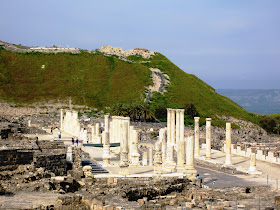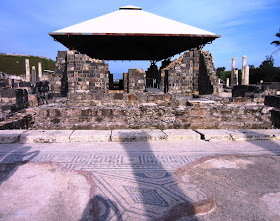Israel really has a thing for lookouts. If there is a prominence, it has a lookout on it. But who can blame them when this is the view?
The region was first settled 5,000-6,000 years ago. It was conquered by the Egyptians 3,500 years ago, and then by the Philistines. When King Saul killed himself in battle on Mount Gilboa rather than be killed by his enemies, the Philistines recovered his body and hung it up in the city, which by then was known as Bethshan or Beit She'an (see 1 Samuel 31). In about 700 BC the city was destroyed by fire, then rebuilt by the Greeks, and around 400 AD during the Roman era, it reached a peak of 30,000 to 40,000 inhabitants. It is the remains of that era that comprise the Beit She'an National Park.
There was a model that gave us an idea of how the ancient city was laid out.
 Beit She'an is one of the cities of the Decapolis and is the only one west of the Jordan River.
Beit She'an is one of the cities of the Decapolis and is the only one west of the Jordan River.
It reminded us a lot of the amphitheater we saw in Caesarea.
The stage can be seen on the left side of the photo below:


A striking red cross rises over a pool in one of the corners of the bathhouse. Perhaps this was a baptismal font during the Byzantine era?
Gotta love the VERY public toilets lined up on that bench against the back wall:
This Corinthian pillar capital is adorned with the face of Dionysus (Greek) or Bacchus (Roman), the god of wine and the city's patron.
Ruins of other structures resemble a rat's maze:
Beit She'an was destroyed by a massive 8.0 earthquake in 749. There are several areas where the pillars in the ground all fell in the same direction. Apparently this is classic pillar behavior during earthquakes:
Before we went to Beit She'an National Park, we stopped at the Beit She'an overlook, which has a great view of the junction of the Jordan River Valley and Jezreel Valley.
It's a popular place among the locals. We saw a few groups of picnickers having a good time:
We made our way back down to the valley, passing the ruins of what Wikipedia says is a Crusader castle. (Sometimes I get lucky with my random photos):There was a model that gave us an idea of how the ancient city was laid out.
The ruins are impressive and extensive, much like the Roman Forum or Ephesus:
. . . complete with a wide, colonnaded avenue:
 Beit She'an is one of the cities of the Decapolis and is the only one west of the Jordan River.
Beit She'an is one of the cities of the Decapolis and is the only one west of the Jordan River.
Forests of columns dotting the cityscape . . .
. . . reminded me of the streetlamp forest in front of the Los Angeles County Museum of Art:
 |
| Photo from here |
There are breathtaking views in every direction:
I love these decorative pieces. I can't imagine the skill required to chisel a floral border like this into stone:
Respectable Roman ruins of any size often have an amphitheater. This one seated 6,000-7,000.It reminded us a lot of the amphitheater we saw in Caesarea.
The stage can be seen on the left side of the photo below:


My favorite part of the city was the remarkably intact Byzantine bathhouse. The floor was suspended over these brick cones, through which hot air was pumped. As the cones heated up, they heated the water around them, which in turn heated the room like a sauna.
A model shows that the bathhouse was huge:
It included a swimming pool, massage rooms, public toilets, and other conveniences. According to information at the site, the bathhouse was an important part of Roman social life, bringing people together not only hygiene purposes, but also for socializing and business.A striking red cross rises over a pool in one of the corners of the bathhouse. Perhaps this was a baptismal font during the Byzantine era?
Gotta love the VERY public toilets lined up on that bench against the back wall:
Luckily, there were also modern toilets available, complete with actual toilet paper and unintelligible signs:
Beautiful mosaic floors were uncovered in the bathhouse and in other places around the ruins:This Corinthian pillar capital is adorned with the face of Dionysus (Greek) or Bacchus (Roman), the god of wine and the city's patron.
Ruins of other structures resemble a rat's maze:
Beit She'an was destroyed by a massive 8.0 earthquake in 749. There are several areas where the pillars in the ground all fell in the same direction. Apparently this is classic pillar behavior during earthquakes:
By the time we were done exploring Beit She'an, we had wandered far from the entrance. We were grateful for this new-fangled vehicle that shuttled us back to our starting point.
Interestingly, there was evidence of recent foreign invasion not far from Beit She'an.
I guess the city continues to be conquered.






































It's always so fun to see someone else's pictures of the places we visited. I especially like the picture of all of the columns with the green-hilled tel behind it.
ReplyDeleteYour pictures are much, much better than mine. Were we on the same trip? Mine are full of people, you've got many with nary a person. Beit She'an was amazing until we went to Jerash and the scope of the ruins and their conditions there dwarfed Beit She'an, but this was still a great site.
ReplyDeleteSo I am wondering where were those off-sight laborer so who pumped the hot air into those cones in the bathhouse? Must have been quite the feat. Interesting place with exquisite stone carvings.
ReplyDelete